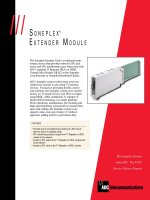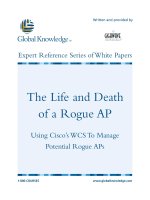Tài liệu Expert Reference Series-Benchmarksprove pdf
Bạn đang xem bản rút gọn của tài liệu. Xem và tải ngay bản đầy đủ của tài liệu tại đây (1.07 MB, 20 trang )
Expert Reference Series
www.globalknowledge.com
1-800-COURSES
Written and Provided by
Benchmarks prove the performance of the Red Hat Enterprise Linux
platform
By: Nick Carr, Jeremy Hogan and Jonathan Opp
October 2002
Abstract
This paper describes how database benchmarks demonstrate the performance
of Red Hat Enterprise Linux AS and Oracle9i Database running on HP ProLiant
hardware. Combined with the compelling Total Cost of Ownership model
presented by this software and hardware combination, the paper shows why
solutions such as this are rapidly replacing proprietary RISC/Unix and Microsoft
Windows solutions.
Revision 2 - February 2003
Copyright ©2003 Red Hat, Inc.
Table of Contents
Executive Summary.................................................................................................3
Price/Performance...............................................................................................3
TPC-C and ECperf Benchmarks............................................................................4
TPC-C Benchmark...............................................................................................4
ECperf Benchmark..............................................................................................6
Total Cost of Ownership.........................................................................................7
IDC TCO Study ...................................................................................................8
Robert Frances TCO study.................................................................................9
Red Hat Enterprise Linux product family...........................................................10
Oracle9i Real Application Clusters.....................................................................12
Key benefits of RAC..........................................................................................12
HP ProLiant.............................................................................................................13
An HP ProLiant Customer: Primesteam..........................................................14
Conclusion...............................................................................................................15
Appendix A - TPC-C Executive Summary..........................................................16
Appendix B - ECPERF Summary Statement.....................................................19
Red Hat Enterprise Linux benchmark results 2
Executive Summary
During the Summer of 2002 TPC-C and ECperf Benchmark results were
published that dramatically demonstrated the benefits of migrating to a Red Hat
Enterprise Linux/Intel-based Architecture/HP ProLiant platform. These
configurations can offer significant performance and cost advantages over a
traditional RISC/Unix environment.
HP Proliant servers delivered the first Linux TPC-C benchmark results running
Oracle9i RAC on Red Hat Linux Advanced Server (this product has since been
renamed to Red Hat Enterprise Linux AS
1
). In that benchmark, an 8-node, 32-
processor cluster of DL580 servers achieved 138,362.03 transactions per
minute (tpmC) at a cost of $17.38/tpmC, setting a new price performance world
record for a clustered database. This benchmark illustrated the
price/performance leadership of Red Hat Enterprise Linux AS on HP Proliant
Intel-based servers, out-performing a configuration running Microsoft Windows
2000 Advanced Server and Microsoft SQL Server 2000 on a IBM eServer
xSeries 370 cluster with 32 processors.
(1)As of October 16, 2002: HP ProLiant DL580R, with 32 Intel Pentium III 900 MHz processors, Oracle9i Database Release 2 with Real
Application Clusters on Red Hat Linux Advanced Server, 138,362.03, $17.21/tpmC, available 03/05/03.
(2)As of October 16, 2002: HP ProLiant DL580R, with 32 Intel Pentium III 900 MHz processors, Oracle9i Database Release 2 with Real
Application Clusters on Windows 2000 Advanced Server, 137,260.89 tpmC, $18.46/tpmC, available 9/6/02.
(3)As of October 16, 2002: IBM eServer xSeries 370 with 32 Intel Pentium III 900 MHz processors, Microsoft SQL Server 2000 on
Windows 2000 Advanced Server, 121,319.23 tpmC, $18.97 tpmC, available 5/31/01.
Source: Transaction Processing Council (TPC),
With this benchmark, HP ProLiant servers became the first industry-standard
server platform to offer enterprise-class performance for a clustered Oracle
Database in a Linux environment. It clearly demonstrates the cost and
maintenance benefits of running Linux-based software and industry-standard
hardware in enterprise operating environments.
The objective of this document is to describe the levels of stability, scalability
and reliability that can be achieved using this platform. In each case presented,
the Red Hat/Oracle/HP combination was the clear winner in price and
performance. Simply put, these solutions deliver better performance for the
price. In certain comparisons the performance improvements are very significant
and achievable at a fraction of the cost of other solutions.
Price/Performance
Red Hat Enterprise Linux AS has been optimized to provide exceptional
1 In March 2003 Red Hat Linux Advanced Server was renamed to Red Hat Enterprise Linux AS. While this paper
generally refers to the product by its new name, the benchmarks described, and the audited and published
results, were completed prior to the name change. As a result the original name is used in all formal benchmark
documentation.
Red Hat Enterprise Linux benchmark results 3
performance on Intel X86-compatible chipsets. Real-world examples from
enterprise users suggest that Red Hat Enterprise Linux AS 2.1 running on the
Intel Pentium 4 chip is able to match the performance of Solaris 8 when running
natively compiled C/C++ or Java code. Additional optimizations in specific
instances have been able to achieve two-to-five times increases in performance
over the application performance on Solaris. It is important to recognize that with
less expensive Intel-based hardware, it is probable that customers can purchase
substantially faster and more well-equipped industry-standard systems than they
would be able to get for the same price from with Solaris, allowing a dramatic
leap over Solaris in cost/performance.
Such statements, however, are directed only at raw processing performance. In
terms of I/O and network throughput, evidence suggests that the two
architectures are closer to parity. Fibre Channel attached storage reads, for
example, will not usually be noticeably faster on Linux than Solaris. However,
this still permits Linux a cost/performance edge because of the high value of HP
ProLiant servers. In certain networking circumstances, Linux is able to best
Solaris performance, although more at the application level than in terms of raw
TCP/IP or UDP throughput capabilities.
TPC-C and ECperf Benchmarks
The following paragraphs describe the recent audited benchmark results
achieved on the Red Hat Enterprise Linux AS operating system. It is worth
noting the rapid advances that have been made in Linux performance over the
past 12-18 months; the figures achieved in these benchmarks are nearly double
what could have been reached in 1999 or 2000. This rate of improvement
underscores the effectiveness of the Open Source development methodology
when combined with the experience of industry leaders such as Oracle and HP.
TPC-C Benchmark
Benchmark C from the Transaction Processing Performance Council is an online
transaction processing (OLTP) database server benchmark. The TPC-C is a
highly regarded benchmark that simulates a variety of transactions at various
user loads. The benchmark measures the throughput of a database server in an
OLTP client/server environment.The power and capacity of database software
and server hardware are measured in transactions per minute (tpmC).
The benchmark compares the tpmC results with the cost of hardware, software
and support for three years to get price/performance values.
TPC-C simulates an environment where a body of virtual users is measured
performing a variety of interactive transactions. The best simulations are not
limited to a particular branch, but reflect an industry of activity. Though the test
focuses on online retail activity, the results are applicable to any enterprise that
must manage the sale and distribution of any product or service.
Red Hat Enterprise Linux benchmark results 4
The configuration used by the Red Hat Enterprise Linux AS, Oracle9i Real
Application Clusters (RAC) and HP ProLiant server benchmark is shown in
Figure 1. Eight 4-CPU DL580 servers hosted the Oracle9i Real Application
Clusters database, which was located on 18TB of storage (configured using
SAN Fibre Channel switches and 32 HP MSA1000 storage subsystems). The
complete configuration had approximately 1,000 disk drives. 16 dual processor
DL360 systems were configured as the database clients.
Figure 1 - TPC-C Benchmark Configuration
HP Proliant DL580 G1 servers running Red Hat Enterprise Linux AS not only
delivered the first Linux TPC-C benchmark results running Oracle9i Real
Application Clusters, but also set a new world record in price/performance for a
clustered database.
Table 1 outlines the results from the three benchmarks published on the
Transaction Processing Performance Council web site.
Company Throughput TPC-C
Performance
Price/System Operating
Database
Hewlett Packard 138,362 tpmC $17.87 Red Hat Linux
Advanced Server 2.1
Oracle9iRAC
IBM 121,319 tpmC $18.97 Microsoft Windows
2000 Advanced Server
SQL Server 2000
Hewlett Packard 137,260 tpmC $18.46 Microsoft Windows
2000 Advanced Server
Oracle9iRAC
Table 1 - TPC-C Benchmark Results
.As of September 17, 2002: HP ProLiant DL580R, with 32 Intel Pentium III 900 MHz processors, Oracle9i Database Release 2 with
Real Application Clusters on Red Hat Enterprise Linux AS, 138,362.03 (Oracle best 32 processor cluster result - original publication
date 9/16/02), $17.38/tpmC, available 03/05/03 (1). HP ProLiant DL580R, with 32 Intel Pentium III 900 MHz processors, Oracle9i
Database Release 2 with Real Application Clusters on Windows 2000 Advanced Server, 137,260.89 tpmC, $18.27/tpmC, available
9/6/02. IBM eServer xSeries 370 with 32 Intel Pentium III 900 MHz processors, Microsoft SQL Server 2000 on Windows 2000
Advanced Server, 121,319.23 tpmC (Microsoft best 32-processor cluster result - result withdrawn 9/17/02), $18.97 tpmC, available
Red Hat Enterprise Linux benchmark results 5
5/31/01 (2). The TPC-C is an OLTP (online transaction processing) benchmark developed by the Transaction Processing Performance
Council (TPC). The TPC-C benchmark defines a rigorous standard for calculating performance and price/performance measured by
transaction per minute (tpmC) and $/tpmC, respectively. Source: Transaction Processing Council (TPC),
The table illustrates that you get greater business throughput with a Red Hat,
HP, Oracle system than with Microsoft Windows 2000, at a lower cost. The
solution provides more transactions completed, more customers served, for a
lower cost of selling in terms of time and price.
The Executive Summary Report for the benchmark is included in the
Appendices, and results from all TPC benchmarks can be found at http:
//www.tpc.org.
ECperf Benchmark
ECperf is a benchmark for measuring performance and scalability of J2EE
servers. ECperf measures the performance and scalability of distributed
JavaBeans applications under interactive load patterns. It is a relatively new
benchmark, designed for today's application server market.
ECperf uses the metaphor of a manufacturing and supply chain management
system to create a real-life, enterprise-level distributed application problem. It
stresses enterprise JavaBean capability to handle complex interactive
transaction environments. Like TPC-C, ECperf compares the number of
transactions to the cost of ownership over a period of time. The configuration for
the recent Red Hat Enterprise Linux AS, Oracle9i Application Server
(Oracle9iAS) and HP ProLiant benchmark is shown in Figure 2. The Application
Servers were comprised of three dual-CPU DL360 G2 servers while the
Database Server comprised a single 4-CPU ML570R configured with 16GB of
memory and approximately 160GB of disk space.
Table 2 compares the performance of three recent ECperf benchmarks. The HP
DL360G2 solution, which used Red Hat Enterprise Linux AS and Oracle9iAS, is
the price/performance winner. In fact, at the time of writing, this benchmark is
the current world record holder.
System Bbops/min @ STD Price $/Bbops/min @ STD
HP DL360G2 cluster 24639.37 $5.00
Dell Power Edge 4600 8286.73 $6.00
IBM eServer x330 cluster 32581.47 $11.00
Table 2 – ECperf Benchmark Results
ECperf is a J2EE application server benchmark that represents real-world business applications; ECperf results indicate how much a
specific hardware and software configuration costs to operate, and how much performance it delivers. For more information, see http:
//ecperf.theserverside.com/ecperf/index.jsp.
The Summary Statement for the benchmark in included in the Appendices, and
results from all ECperf benchmarks can be found at
http:
//www.theserverside.com/ecperf.
Red Hat Enterprise Linux benchmark results 6
Figure 2 - ECperf Benchmark Configuration
Total Cost of Ownership
Modern benchmarks such as TPC-C and ECperf attempt to synthesize the
complete cost of a given computing environment – as seen above, they include
both price/performance and raw performance results. In most cases the
price/performance results are the most useful to potential customers, since
achieving a leading performance figure is generally a matter of configuring the
largest possible system. But in order to provide price/performance figures the
benchmark auditors require that vendors provide guaranteed costs for hardware
and software, and up to three years of 24x7 support (in the case of TPC-C). This
Red Hat Enterprise Linux benchmark results 7









